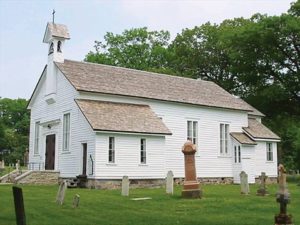 George Hallen was an Anglican priest who served as the first pastor of not one but two new Anglican churches built in Simcoe County in the mid-1800s, both of which are still in use today.
George Hallen was an Anglican priest who served as the first pastor of not one but two new Anglican churches built in Simcoe County in the mid-1800s, both of which are still in use today.
Rev. Hallen was born in England in February 1794. As a young man, he studied at Oxford University before joining the clergy of the Church of England.
In 1833, at age 39, Rev. Hallen immigrated to Canada with his wife and five children, settling in the Township of Medonte two years later. There the Hallen family settled on a farm they purchased from the Bywater family at Lot 11, Concession 13, and moved into the house that had already been built there by the farm’s previous owners.
For five years Rev. Hallen served the local Anglican congregation out of his family’s home. Later, on a return to trip to England, he solicited members of his old parish for funds to help build a proper church for the area, on lands donated by his neighbours, the Hamilton and Steele families. Construction of the church had begun by 1838, using bricks trucked in from Orillia. The church was consecrated in 1842 as St. George’s Church of Fair Valley.
By this time the Rev. Hallen had relocated permanently with his family to the Penetanguishene area, where he became the first pastor of a second new Anglican church, a wood-framed clapboard building which had already been under construction for several years. The new church was named St. James on-the-Lines, referring to its position at the edge of the “lines”, or rows of barracks, of the nearby military establishment.
Located halfway between the military establishment and the town of Penetanguishene, initially St. James on-the-Lines served the soldiers garrisoned at the base and retired soldiers located on two-acre grants along the Penetanguishene Road, as well as local farmers and residents of the fledgling town of Penetanguishene. The church also served residents of Wyebridge, Midland and the surrounding townships until they established Anglican churches of their own.
When the military establishment closed in 1856 and was converted to a boys’ reformatory, the Rev. Hallen became its chaplain. In 19th-century Canada (indeed, until our correctional system was reorganized in 1972), a boys’ reformatory was essentially a detention center for male young offenders, the idea being that removing them from the city, educating them and teaching them vocational skills would help divert them from ending up in a life of crime.
The Rev. Hallen left St. James on-the-Lines around 1876, after 36 years of service. He died in Toronto in 1882, at age 88, and was buried alongside some of his family members and many of his former parishioners in the cemetery of St. James’ Church in Penetanguishene.
According to Andrew Hunter, himself a pioneer of Simcoe County history, in addition to his significant contributions to the Anglican community, the Rev. Hallen was one of the first residents of Simcoe County to take an interest in local history and heritage preservation, commissioning some of the earliest maps of the remains of Ste. Marie Among the Hurons.
Author: John Merritt, Simcoe County Historical Association.
Photo: St. James On-the-Lines Anglican Church, Penetanguishene.